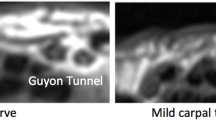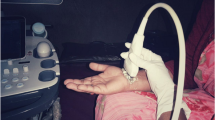Abstract
Objective
The aim of our study is to develop and validate a radiomics model based on ultrasound image features for predicting carpal tunnel syndrome (CTS) severity.
Methods
This retrospective study included 237 CTS hands (106 for mild symptom, 68 for moderate symptom and 63 for severe symptom). There were no statistically significant differences among the three groups in terms of age, gender, race, etc. The data set was randomly divided into a training set and a test set in a ratio of 7:3. Firstly, a senior musculoskeletal ultrasound expert measures the cross-sectional area of median nerve (MN) at the scaphoid-pisiform level. Subsequently, a recursive feature elimination (RFE) method was used to identify the most discriminative radiomic features of each MN at the entrance of the carpal tunnel. Eventually, a random forest model was employed to classify the selected features for prediction. To evaluate the performance of the model, the confusion matrix, receiver operating characteristic (ROC) curves, and F1 values were calculated and plotted correspondingly.
Results
The prediction capability of the radiomics model was significantly better than that of ultrasound measurements when 10 robust features were selected. The training set performed perfect classification with 100% accuracy for all participants, while the testing set performed accurate classification of severity for 76.39% of participants with F1 values of 80.00, 63.40, and 84.80 for predicting mild, moderate, and severe CTS, respectively. Comparably, the F1 values for mild, moderate, and severe CTS predicted based on the MN cross-sectional area were 76.46, 57.78, and 64.00, respectively..
Conclusion
This radiomics model based on ultrasound images has certain value in distinguishing the severity of CTS, and was slightly superior to using only MN cross-sectional area for judgment. Although its diagnostic efficacy was still inferior to that of neuroelectrophysiology. However, this method was non-invasive and did not require additional costs, and could provide additional information for clinical physicians to develop diagnosis and treatment plans.




Similar content being viewed by others
Data availability
The surveys and materials are available upon reasonable
request to the corresponding author.
References
Erickson M, Lawrence M, Lucado A. The role of diagnostic ultrasound in the examination of carpal tunnel syndrome: an update and systematic review. J Hand Ther. 2022;35(2):215–25.
Chen YT, Williams L, Zak MJ, Fredericson M. Review of ultrasonography in the diagnosis of carpal tunnel syndrome and a proposed scanning protocol. J Ultrasound Med. 2016;35(11):2311–24.
Aktürk S, Büyükavcı R, Ersoy Y. Median nerve ultrasound in carpal tunnel syndrome with normal electrodiagnostic tests. Acta Neurol Belg. 2020;120(1):43–7.
Kele H, Verheggen R, Bittermann HJ, Reimers CD. The potential value of ultrasonography in the evaluation of carpal tunnel syndrome. Neurology. 2003;61(3):389–91.
Torres-Costoso A, Martínez-Vizcaíno V, Álvarez-Bueno C, Ferri-Morales A, Cavero-Redondo I. Accuracy of ultrasonography for the diagnosis of carpal tunnel syndrome: a systematic review and meta-analysis. Arch Phys Med Rehabil. 2018;99(4):758-65.e10.
Sarría L, Cabada T, Cozcolluela R, Martínez-Berganza T, García S. Carpal tunnel syndrome: usefulness of sonography. Eur Radiol. 2000;10(12):1920–5.
Yesildag A, Kutluhan S, Sengul N, Koyuncuoglu HR, Oyar O, Guler K, et al. The role of ultrasonographic measurements of the median nerve in the diagnosis of carpal tunnel syndrome. Clin Radiol. 2004;59(10):910–5.
Keleş I, Karagülle Kendi AT, Aydin G, Zöğ SG, Orkun S. Diagnostic precision of ultrasonography in patients with carpal tunnel syndrome. Am J Phys Med Rehabil. 2005;84(6):443–50.
Gregoris N, Bland J. Is carpal tunnel syndrome in the elderly a separate entity? Evidence from median nerve ultrasound. Muscle Nerve. 2019;60(3):217–8.
Moran L, Perez M, Esteban A, Bellon J, Arranz B, del Cerro M. Sonographic measurement of cross-sectional area of the median nerve in the diagnosis of carpal tunnel syndrome: correlation with nerve conduction studies. J Clin Ultrasound. 2009;37(3):125–31.
Beekman R, Visser LH. Sonography in the diagnosis of carpal tunnel syndrome: a critical review of the literature. Muscle Nerve. 2003;27(1):26–33.
Ardakani AA, Afshar A, Bhatt S, Bureau. Diagnosis of carpal tunnel syndrome: a comparative study of shear wave elastography, morphometry and artificial intelligence techniques[J]. Pattern Recognit Lett. 2020;133:77–85.
Keese GR, Wongworawat MD, Frykman G. The clinical significance of the palmaris longus tendon in the pathophysiology of carpal tunnel syndrome. J Hand Surg Br. 2006;31(6):657–60.
El Miedany YM, Aty SA, Ashour S. Ultrasonography versus nerve conduction study in patients with carpal tunnel syndrome: substantive or complementary tests? Rheumatology (Oxford). 2004;43(7):887–95.
Jablecki CK, Andary MT, Floeter MK, Miller RG, Quartly CA, Vennix MJ, et al. WITHDRAWN: Second AAEM literature review of the usefulness of nerve conduction studies and needle electromyography for the evaluation of patients with carpal tunnel syndrome. Muscle Nerve. 2002.
London ZN. Safety and pain in electrodiagnostic studies. Muscle Nerve. 2017;55(2):149–59.
Werner RA, Andary M. Electrodiagnostic evaluation of carpal tunnel syndrome. Muscle Nerve. 2011;44(4):597–607.
Lambin P, Rios-Velazquez E, Leijenaar R, Carvalho S, van Stiphout RG, Granton P, et al. Radiomics: extracting more information from medical images using advanced feature analysis. Eur J Cancer. 2012;48(4):441–6.
Gillies RJ, Kinahan PE, Hricak H. Radiomics: images are more than pictures, they are data. Radiology. 2016;278(2):563–77.
Lambin P, Leijenaar RTH, Deist TM, Peerlings J, de Jong EEC, van Timmeren J, et al. Radiomics: the bridge between medical imaging and personalized medicine. Nat Rev Clin Oncol. 2017;14(12):749–62.
Faeghi F, Ardakani AA, Acharya UR, Mirza-Aghazadeh-Attari M, Abolghasemi J, Ejtehadifar S, et al. Accurate automated diagnosis of carpal tunnel syndrome using radiomics features with ultrasound images: a comparison with radiologists’ assessment. Eur J Radiol. 2021;136:109518.
Rossi F, Bignotti B, Bianchi L, Picasso R, Martinoli C, Tagliafico AS. Radiomics of peripheral nerves MRI in mild carpal and cubital tunnel syndrome. Radiol Med. 2020;125(2):197–203.
Priganc VW, Henry SM. The relationship among five common carpal tunnel syndrome tests and the severity of carpal tunnel syndrome. J Hand Ther. 2003;16(3):225–36.
El Miedany Y, El Gaafary M, Youssef S, Ahmed I, Nasr A. Ultrasound assessment of the median nerve: a biomarker that can help in setting a treat to target approach tailored for carpal tunnel syndrome patients. Springerplus. 2015;4:13–22.
Jablecki CK, Andary MT, Floeter MK, Miller RG, Quartly CA, Vennix MJ, et al. American Academy of, M. American Academy of Physical,Rehabilitation, Practice parameter: electrodiagnostic studies in carpal tunnel syndrome. Report of the American Association of Electrodiagnostic Medicine,American Academy of Neurology, and the American Academy of Physical Medicine and Rehabilitation. Neurology. 2002;58(11):1589–92.
Fowler JR, Gaughan JP, Ilyas AM. The sensitivity and specificity of ultrasound for the diagnosis of carpal tunnel syndrome: a metaanalysis. Clin Orthop Relat Res. 2011;469:1089–94.
Stevens JC. AAEM minimonograph #26: the electrodiagnosis of carpal tunnel syndrome. American Association of Electrodiagnostic Medicine. Muscle Nerve. 1997;20:1477–86.
Wu J, Sun X, Wang J, Cui Y, Kato F, Shirato H, et al. Identifying relations between imaging phenotypes and molecular subtypes of breast cancer: model discovery and external validation. J Magn Reson Imaging. 2017;46(4):1017–27.
Wee TC, Simon NG. Shearwave elastography in the differentiation of carpal tunnel syndrome severity. PM R. 2020;12(11):1134–9.
Moschovos C, Tsivgoulis G, Kyrozis A, Ghika A, Karachalia P, Voumvourakis K, et al. The diagnostic accuracy of high-resolution ultrasound in screening for carpal tunnel syndrome and grading its severity is moderated by age. Clin Neurophysiol. 2019;130(3):321–30.
Ziswiler HR, Reichenbach S, Vögelin E, Bachmann LM, Villiger PM, Jüni P. Diagnostic value of sonography in patients with suspected carpal tunnel syndrome: a prospective study. Arthritis Rheum. 2005;52(1):304–11.
Park D, Kim BH, Lee SE, Kim DY, Kim M, Kwon HD, et al. Machine learning-based approach for disease severity classification of carpal tunnel syndrome. Sci Rep. 2021;11(1):17464.
Tagliafico AS. Peripheral nerve imaging: not only cross-sectional area. World J Radiol. 2016;8(8):726–8.
Sayin R , Keskin S , Hamamci M .Evaluation of several classification methods in carpal tunnel syndrome.Journal of the Pakistan Medical Association,2017, 67(11):1654–7
Wang YW, Chang RF, Horng YS, Chen CJ. MNT-DeepSL: Median nerve tracking from carpal tunnel ultrasound images with deep similarity learning and analysis on continuous wrist motions. Comput Med Imaging Graph. 2020;80:101687.
AAAA B, AA C, SB D, NJB E, ATAB F, U Rajendra Acharya g h i j, et al. Diagnosis of carpal tunnel syndrome: a comparative study of shear wave elastography, morphometry and artificial intelligence techniques - ScienceDirect. Pattern Recognition Letters 133(2020):77–85.
Elseddik M, Alnowaiser K, Mostafa RR, Elashry A, El-Rashidy N, Elgamal S, et al. Deep learning-based approaches for enhanced diagnosis and comprehensive understanding of carpal tunnel syndrome. Diagnostics (Basel). 2023;13(20):3211.
Lyu S, Zhang Y, Zhang M, Zhu J, Yu J, Zhang B, et al. The application of ultrasound image-based radiomics in the diagnosis of mild carpal tunnel syndrome. J Ultrasound Med. 2023;42(7):1499–508.
Park D, Kim BH, Lee SE, Kim DY, Kim M, Kwon HD, et al. Machine learning-based approach for disease severity classification of carpal tunnel syndrome. Sci Rep. 2021;11(1):17464.
Li G, Liu J, Wu J, Tian Y, Ma L, Liu Y, et al. Diagnosis of renal diseases based on machine learning methods using ultrasound images. Curr Med Imaging. 2021;17(3):425–32.
Ampomah E K , Qin Z , Nyame G .Evaluation of tree-based ensemble machine learning models in predicting stock price direction of movement.Information (Switzerland), 2020, 11(6):332
De Kleermaeker FGCM, Meulstee J, Claes F, Kasius KM, Verhagen WIM. Treatment outcome in patients with clinically defined carpal tunnel syndrome but normal electrodiagnostic test results: a randomized controlled trial. J Neurol. 2017;264(12):2394–400.
Acknowledgements
The authors are grateful for the contributions of all patients in the study. We would also like to thank all staff members for participating in this study.
Funding
The study was funded by the Project of NINGBO Leading Medical&Health Discipline, Project Number:No.2022-S02, Ningbo Clinical Research Center for Medical Imaging (No. 2021L003), and Medical Scientific Research Foundation of Zhejiang Province, Grant No.2021KY294 and 2023KY1098.
Author information
Authors and Affiliations
Contributions
Conception and design: Shuyi LYU, Meiwu Zhang, Jianjun Yu, and Qiaojie Chen; acquisition and analysis of data: Shuyi LYU, Baisong Zhang, Libo Gao, Jiazhen Zhu, and Qiaojie Chen; drafting the article: Shuyi LYU, Meiwu Zhang, Jianjun Yu, Jiazhen Zhu, Baisong Zhang, Libo Gao, Dingkelei Jin, and Qiaojie Chen. All the authors approved the final article.
Corresponding author
Ethics declarations
Ethics approval
The study was approved by the local hospital ethics board (YJ-NBEY-KY-2022–072-01).
Informed consent statement
The requirement for informed consent was waived because of the retrospective nature of the study.
Conflict of interest
The authors declare no competing interests.
Additional information
Publisher's Note
Springer Nature remains neutral with regard to jurisdictional claims in published maps and institutional affiliations.
Rights and permissions
Springer Nature or its licensor (e.g. a society or other partner) holds exclusive rights to this article under a publishing agreement with the author(s) or other rightsholder(s); author self-archiving of the accepted manuscript version of this article is solely governed by the terms of such publishing agreement and applicable law.
About this article
Cite this article
LYU, S., Zhang, M., Yu, J. et al. Application of radiomics model based on ultrasound image features in the prediction of carpal tunnel syndrome severity. Skeletal Radiol 53, 1389–1397 (2024). https://doi.org/10.1007/s00256-024-04594-7
Received:
Revised:
Accepted:
Published:
Issue Date:
DOI: https://doi.org/10.1007/s00256-024-04594-7




